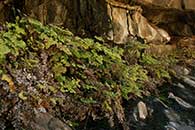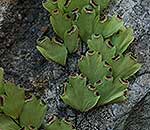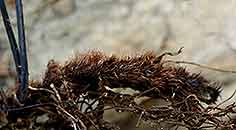Adiantum capillus-veneris L.
Synonyms |
Adiantum capillus Sw., nom. illegit. |
|---|---|
Common name |
Maidenhair fern |
Description |
Rhizome creeping, 2-8 mm in diameter; rhizome scales awl-shaped, apex gradually tapering to a point, margin entire, c. 3 mm long, brown. Fronds monomorphic, closely spaced, erect or arching, herbaceous. Stipe thin, wiry, up to 25 cm long, dark brown to purplish black, shining, glabrous. Lamina 2-3 pinnate, pinnate near the apex, triangular to ovate-deltate in outline, 20 × 18 cm; pinnules persistent, wedge-shaped with straight sides, entire to deeply incised on the outer margin into narrow lobes with outer margin minutely toothed, 0.8-2.5 × 0.6-2.8 cm, veins ending in the marginal serrations; rhachis and stalks black, shiny, glabrous. Sori 2-6, beneath pinnule lobes on the undersurface of deflexed indusial flaps, 1-2 mm long, 1-5 mm wide; indusial flaps oblong or slightly curved, membranous, pale brown, glabrous. |
Notes | A. capillus-veneris is 2-3 pinnate. It can be distinguished from similar species (A. poiretii or A. raddianum) by having oblong or lunulate sori and veins of the pinnules that end in the teeth of the serrations of the outer margins. |
Derivation | capillus-veneris: hair of venus |
Habitat | On moist cliff faces, on boulders and along streams or moist ditches, in low-altitude woodland or medium-altitude riverine forest, exposed or shaded. Very occasional epiphytic on trees in spray of waterfalls. |
Distribution worldwide | Widespread in Africa, with the exception of West Africa. Throughout tropical, sub-tropical and warmer-temperate regions in the rest of the world. |
Distribution in Africa |
Algeria, Angola, Botswana, Chad, Dem. Republic of Congo, Djibouti, Egypt, Ethiopia, Kenya, Lesotho, Libya, Malawi, Mali, Mauritania, Morocco and Western Sahara, Mozambique, Namibia, Nigeria, Rwanda, Somalia, South Africa, Sudan and South Sudan, Swaziland, Tanzania , Tunesia, Uganda, Zambia, Zimbabwe. |
Growth form |
Lithophytic, terrestrial. |
Literature |
|




